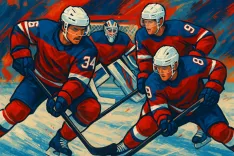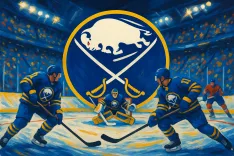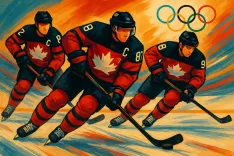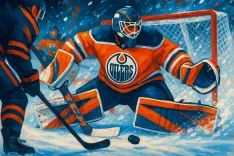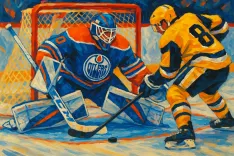Envisioning the Future of Olympic Hockey: A 3-on-3 Format

Hockey enthusiasts around the globe are eagerly anticipating the return of NHL players to the Winter Olympics in 2026. The prospect of seeing the world's top athletes represent their nations and compete for gold generates some of the most thrilling moments in the sport. This excitement begs the question: what would happen if the traditional 5-on-5 format of hockey was condensed into 3-on-3 play? The International Ice Hockey Federation (IIHF) is considering this innovative format for the 2030 Olympic Games and is in the process of drafting a proposal to explore its viability. Imagine experiencing the frenetic pace of NHL overtime extended throughout an entire game, offering an exhilarating spectacle for fans. This concept echoes the recent implementation of a 3-on-3 format seen in basketball during the Summer Olympics in Paris, yet with hockey, there's a clear understanding of how the elite talent would perform together on the ice. To that end, the following analysis proposes ideal 3-on-3 rosters, including goalies, for various nations in anticipation of the 2026 Olympics.
For Canada, selecting a powerful trio is paramount, and the combination of Connor McDavid, Sidney Crosby, and Cale Makar presents an unmatched opportunity to dominate. While Canada has produced countless forward and defensive pairings that could easily prevail against international competition, this lineup ensures an electrifying and creative output. The synergy between McDavid and Crosby is likened to a fantasy scenario often experienced in video games. With Makar's offensive prowess complementing their play, this formation creates a near-insurmountable challenge for any opponent. Although Crosby will be on the older side come 2026, his experience and skill remain irreplaceable. In goal, Jordan Binnington has been selected despite criticism from some fans. Notably, options such as Cam Talbot, Adin Hill, and Stuart Skinner are also on the radar, highlighting a depth of talent that Canada can call upon.
The United States can boast an equally enticing 3-on-3 roster, featuring Auston Matthews, Jack Hughes, and Quinn Hughes. The dynamic scoring ability of Matthews, paired with Jack Hughes' agility and puck-handling skills, creates an exciting offensive dynamic. The inclusion of Quinn Hughes adds a defensive skill set while simultaneously supporting the offensive flow. This trio promises to capture the attention of fans worldwide, ensuring constant action when they take the ice. With Connor Hellebuyck tending the net, the U.S. lineup combines scoring potential with capable goaltending, further solidifying their chances for success in a 3-on-3 format.
For Sweden, the decision-making process diversifies as they consider the possibility of utilizing a trio of defensemen alongside excellent forwards. Nevertheless, Filip Forsberg and William Nylander are formidable choices to spearhead their offensive charge. With both players exhibiting exceptional skill and creativity, they will undoubtedly contribute to exciting scoring opportunities. To solidify the defensive aspect, veteran Victor Hedman is selected, bringing with him experience and leadership. Although options such as Gustav Forsling and Rasmus Dahlin are also commendable, Hedman's stature in international play places him at the forefront of this lineup. In goal, Filip Gustavsson has been chosen, although Linus Ullmark and Jacob Markström also present strong cases for selection, showcasing the depth of Swedish hockey talent.
Finland's potential lineup is equally impressive, led by Aleksander Barkov, Mikko Rantanen, and Miro Heiskanen. Barkov's ability to score, paired with his defensive capabilities, allows him to effectively contribute to both ends of the ice. Rantanen is recognized as one of Finland's premier scoring threats since the days of Teemu Selanne, often finding ways to accumulate points efficiently. Complemented by Heiskanen's defensive prowess, this trio offers Finland a well-rounded threat as they navigate the 3-on-3 format. In goal, Juuse Saros is the likely candidate, given his status as Finland's top goaltender at the moment, with Ukko-Pekka Luukkonen and Kevin Lankinen also providing respectable alternatives.
Czechia’s roster displays promise, particularly with David Pastrnak, Martin Necas, and Filip Hronek forming a dynamic group. Pastrnak's potent scoring ability will play a pivotal role in pushing their offensive agenda, while Necas, who has been enjoying a breakout season, can facilitate play effectively. The challenge lies in selecting a defensively capable player, and Filip Hronek fits the bill with his capacity to contribute offensively in a 3-on-3 format. In net, Lukas Dostal has emerged as a rising star for the Anaheim Ducks, suggesting that he may soon assume the starting position for Czechia's team in international competitions.
Finally, the opportunity to evaluate a potential Russian lineup features an abundance of talent among forwards. Despite the current restrictions preventing Russia from competing in international events, anticipation remains for their eventual return to the Olympic stage. Within this framework, the trio of Nikita Kucherov, Alex Ovechkin, and Kirill Kaprizov emerges as a formidable force. Ovechkin, even at the age of 41, is expected to maintain his status as a prolific scorer, and alongside the dynamic talents of Kucherov and Kaprizov, this offense promises to captivate fans. In goal, Igor Shesterkin stands out as the premier goaltender, capable of backing up an exciting and high-scoring offense. With this carefully curated lineup, the potential of Russian hockey on the international stage presents an impressive picture.
As hockey fans eagerly await the future of the sport's competition at the Olympic level, the introduction of a 3-on-3 format promises to offer unprecedented entertainment, showcasing the extraordinary talents of nations and how they can blend individual skills into a cohesive unit.
